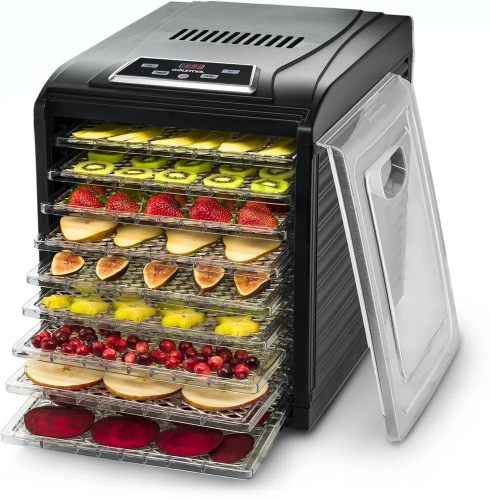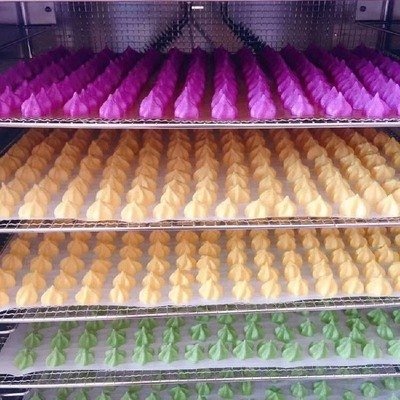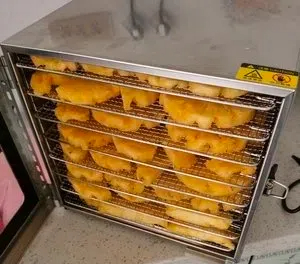
Content Menu
● Introduction
● Understanding Food Dryers
>> How Food Dryers Work
● Benefits of Using Food Dryers
>> Nutritional Preservation
>> Cost-Effectiveness
>> Convenience and Versatility
● Choosing the Right Food Dryer
>> Popular Brands and Models
● How to Use a Food Dryer Effectively
>> Step-by-Step Guide to Drying Various Foods
>> Tips for Optimal Results
● Common Mistakes to Avoid
>> Overloading the Dryer
>> Incorrect Temperature Settings
● Innovative Uses for Dried Foods
● Conclusion
● Frequently Asked Questions
>> 1. What types of foods can be dried?
>> 2. How long does it take to dry food?
>> 3. Can I dry meat in a food dryer?
>> 4. What is the best temperature for drying fruits?
>> 5. How do I clean my food dryer?
Introduction
Food preservation is a crucial aspect of maintaining the quality and safety of our food supply. Among various methods, food drying stands out as an effective technique that not only extends shelf life but also enhances flavors. This article delves into the world of food dryers, exploring their functionality, benefits, and practical applications in everyday cooking.

Understanding Food Dryers
Food dryers, also known as dehydrators, are appliances designed to remove moisture from food, thereby inhibiting the growth of bacteria, yeast, and mold. There are several types of food dryers, including electric dehydrators, solar dehydrators, and microwave dehydrators. Each type operates on the same principle: using heat and airflow to evaporate moisture.
How Food Dryers Work
Food dryers utilize a fan and a heating element to circulate warm air around the food. This process gradually reduces the moisture content, preserving the food's nutrients and flavor. The temperature and airflow can be adjusted based on the type of food being dried, ensuring optimal results.
Benefits of Using Food Dryers
Nutritional Preservation
One of the primary advantages of using a food dryer is the preservation of nutrients. Unlike canning or freezing, which can lead to nutrient loss, drying retains most vitamins and minerals, making dried foods a healthy snack option.
Cost-Effectiveness
Investing in a food dryer can save money in the long run. By purchasing fruits and vegetables in bulk and drying them at home, consumers can avoid the high costs of pre-packaged dried foods.
Convenience and Versatility
Food dryers are incredibly versatile. They can be used to dry a wide range of foods, including fruits, vegetables, herbs, and even meats. This versatility allows home cooks to experiment with different recipes and create unique snacks.

Choosing the Right Food Dryer
When selecting a food dryer, several key features should be considered:
1. Capacity: Depending on the volume of food you plan to dry, choose a model with adequate capacity.
2. Temperature Control: Look for a dryer with adjustable temperature settings to accommodate different types of food.
3. Ease of Cleaning: Removable trays and dishwasher-safe components can simplify the cleaning process.
Popular Brands and Models
Some of the top-rated food dehydrators include the Excalibur, Nesco, and Magic Mill. Each brand offers unique features that cater to different drying needs.
How to Use a Food Dryer Effectively
Step-by-Step Guide to Drying Various Foods
1. Preparation: Wash and slice the food into uniform pieces to ensure even drying.
2. Pre-treatment: Some fruits, like apples and bananas, benefit from a quick soak in lemon juice or a saltwater solution to prevent browning.
3. Loading the Dryer: Arrange the food in a single layer on the trays, ensuring adequate airflow.
4. Setting the Temperature: Adjust the temperature based on the food type (e.g., 135°F for fruits, 145°F for meats).
5. Monitoring: Check the food periodically to ensure it dries evenly and adjust the time as needed.
Tips for Optimal Results
1. Avoid overcrowding the trays to allow for proper air circulation.
2. Rotate the trays halfway through the drying process for even results.
Common Mistakes to Avoid
Overloading the Dryer
One of the most common mistakes is overloading the dryer, which can lead to uneven drying and longer processing times. Always follow the manufacturer's guidelines for maximum load capacity.
Incorrect Temperature Settings
Using the wrong temperature can result in improperly dried food. Always refer to drying guides for specific temperature recommendations based on the food type.
Innovative Uses for Dried Foods
Dried foods can be used in a variety of creative ways:
1. Snacks: Dried fruits and vegetables make for healthy snacks.
2. Cooking Ingredients: Incorporate dried herbs and vegetables into soups, stews, and sauces for added flavor.
3. Camping and Hiking: Dried meals are lightweight and easy to pack, making them ideal for outdoor adventures.
Conclusion
Food dryers are an invaluable tool for anyone interested in food preservation. They offer a cost-effective, nutritious, and versatile way to enjoy a variety of foods year-round. By understanding how to use a food dryer effectively, you can create delicious snacks and meals that are both healthy and convenient.

Frequently Asked Questions
1. What types of foods can be dried?
You can dry fruits, vegetables, herbs, meats, and even flowers using a food dryer.
2. How long does it take to dry food?
Drying times vary based on the type of food and thickness of slices, typically ranging from 4 to 12 hours.
3. Can I dry meat in a food dryer?
Yes, many food dryers are designed to safely dry meats, but ensure you follow proper food safety guidelines.
4. What is the best temperature for drying fruits?
Fruits are generally dried at temperatures between 125°F and 135°F.
5. How do I clean my food dryer?
Most food dryers have removable trays that can be washed in warm soapy water or placed in the dishwasher for easy cleaning.












